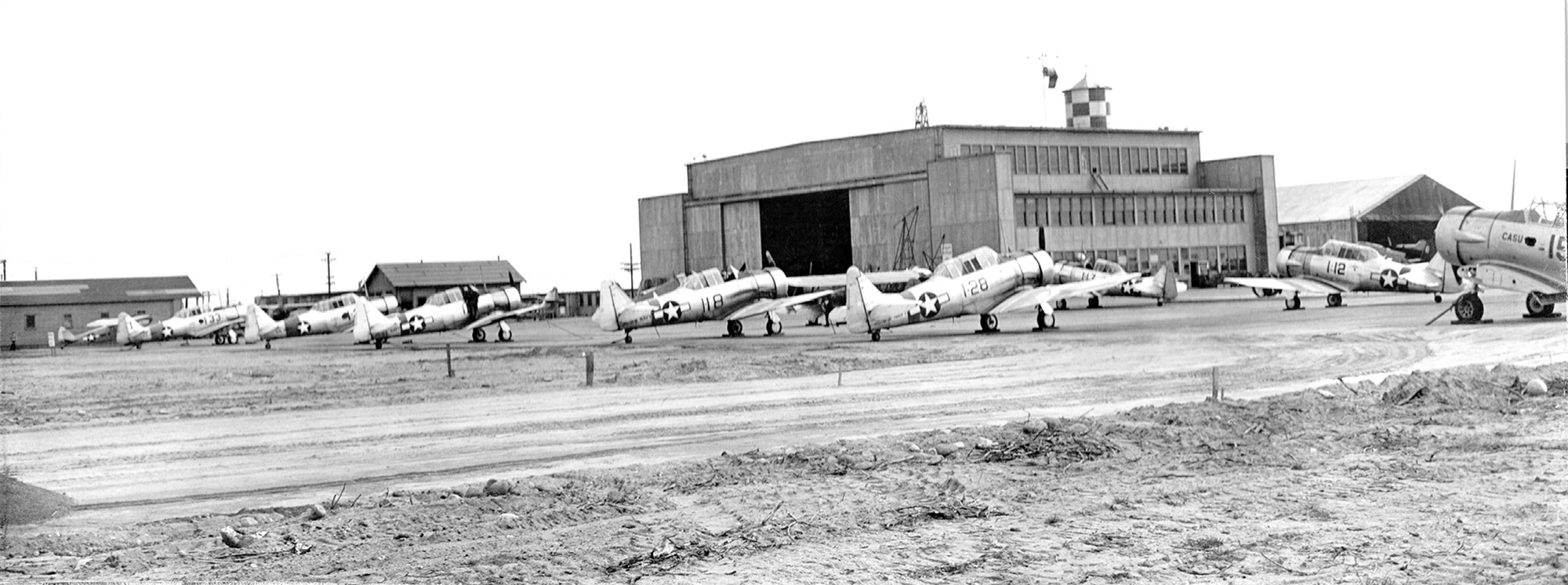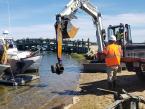In early 1943, as Allied forces pushed their way into Sicily and the tide of war began to change in the Pacific, the American Navy began a small, seemingly insignificant stealth operation on a small Island eight miles off the coast of Massachusetts.
“The airfield on the central plain of Martha’s Vineyard is beginning to shape up . . . which has brought life and a strange new pattern to a domain where only the hawks, rabbits and wildflowers have dwelt for many a generation,” the Vineyard Gazette reported on April 16, 1943.
The story went on to add that the U.S. Naval Auxiliary Air Facility, as it came to be known, was surrounded by enough barbed wire to “stretch the length of the Vineyard two or three times,” providing secrecy for a nearly 700-man Naval training facility carved out of a scrub oak wilderness in the state forest.
“It is an island within an Island,” the story concluded.
But now, with the recent discovery of World War II-era bomber buried beneath the Cape Pogue seafloor for the past 73 years, the clandestine history of the Island’s involvement in World War II has come to the surface as well.
The state of Massachusetts leased the forestland that is today the Martha’s Vineyard Airport to the Navy for the duration of the war, allowing a total of 21 fighter, torpedo, scouting, composite and carrier squadrons to perform target and proficiency practice on the Island between 1944 and 1946. While the lease price was only $1, the cost in lives lost during those exercises was far greater — and something the Navy wanted to keep quiet — as many of the young men who came to the Vineyard to train for aerial combat in Europe and the Pacific never left.
Tom Dunlop, an Edgartown journalist who helped research the SB2C Helldiver that will soon be pulled out of Cape Pogue Bay for positive identification, said from his reading of the Gazette records of plane crashes, an estimated 35 to 40 men died while training during a 16-month period in the middle of the war.
“It was mayhem out there,” Mr. Dunlop said. “They either got lost in the fog, or there were collisions, or they just weren’t ready to do the maneuvers they were called upon to do.”
Despite press restrictions that were in place during wartime, the Gazette recorded details from the crashes, including the names of those who died and their place of birth.
“There were voluntary press restrictions, you couldn’t report maneuvers,” Mr. Dunlop said. “But you couldn’t hide it because people saw. The stories were quick-pick. So the Vineyard got a pretty clear picture of the price that was being paid, even if they didn’t know what it exactly was going on.”
A Dec. 24, 1943 story describes the limitations.
“Restrictions . . . have prevented the publication of any material regarding the types of planes at the Martha’s Vineyard Naval Auxiliary Air Facility, the activities which are held, or the purposes for which it is designed,” it said.
But the paper wrote about the fatalities nonetheless, with dozens of head lines spelling the details: “Fliers Lost,” “Heroism at Noman’s,” “Pilot Falls to His Death,” “Planes Collide at Sea,” and “Plane Disappears.” Nearly all of them included names, rank, and biographical information about the men who perished.
The fliers, generally age 20 or younger — men in name only — came to train on the Vineyard because of its remoteness, small population, and similarity to islands in the Mediterranean and the North Pacific. The Island’s specialty was nighttime carrier takeoffs and landings, with planes often leaving from the Quonset Naval Air Station in Rhode Island, dropping practice bombs at Little Neck, Katama Bay, Gay Head, Noman’s Land, or other isolated, seldom-visited corners of the Island, and then returning to the Naval Auxiliary Air Station.
For those who survived, the Vineyard posting was nothing short of paradise.
“I’m in heaven!” recalled World War II ace Howard Henrickson in an interview with Martha’s Vineyard Museum oral historian Linsey Lee. “Couldn’t ask for a better duty. We loved the freedom here. We took full advantage of . . . the summer months.” Mr. Henrickson would go on to earn dozens of medals for his service in the European theatre during the war. Some, tragically, weren’t so lucky. A 1945 story in the Gazette details a two-day period that saw two plane crashes and six deaths, with all the men under the age of 21 and fliers of two of the 68 NACTULANT, or Night Attack Combat Training Unit-Atlantic, stationed on the Island. “The planes in both instances were en gaged in training flights at night, and extensive searches failed to find wreckage or bodies of the men,” the story reported. “These fatalities, coming on the heels of other tragedies in recent weeks, were taken by the Vineyard public to reflect the hazardous types of training activities carried on from the Island station, hazards being accepted as inseparable from preparation for modern warfare.”
Although the night sky veiled many of the exercises from public scrutiny, savvy Islanders, with whispers that spread like wildfire, found out about the practice bombs — especially after a three-pound bomb was accidentally dropped on the corner of Morse and North Water streets in heart of Edgartown. The incident was chronicled by the Gazette in 1945:
“The bomb went off with the noise of a giant firecracker, according to Mr. Robbins, who was in a position to judge, since it came down not far from his house. His first thoughts included possible trouble with his oil burner, and after a check revealed that all right, he continued his investigation outside, finding the remains of the bomb which had made quite a depression in the concrete sidewalk.”
Others Island civilians, like Chappaquiddick bay scalloper Eddie Belisle, felt they owed the servicemen their silence even though he spent his childhood viewing the bombings — a free fireworks show in the middle of February. In an interview with Ms. Lee, Mr. Belisle described the secret, dangerous exercises around Shear Pen Pond at Cape Pogue.
“There’s so much unexploded ordnance there, you’d die,” Mr. Belisle said. “But it’s like this — ‘Go away — don’t tell anybody — don’t talk about it.’”
He continued:
“So we used to go down at night when they were bombing, because they used practice chutes, parachutes, and they’d shoot the thing up and then light the thing up and light the sky up; then the guy would go down. They used it for dive bombing is what they did. And they put four in the ground. Four dive bombs. Four physical airplanes in the ground.”
Mr. Belisle described one of the planes he saw crash as an SB2C — in his words, a “terrible airplane.”
“They hauled the parts up for, Christ, 20 years, the guys scalloping. Pieces of it, all the time. We went diving for it, Dickie Brown and I. We dove for like I think a week down there and never found anything.”
Decades later, those pieces are finally starting to come together. and something has finally been found. After pulling up a machine gun and propeller, much like the scallopers decades before, the U.S. Army Corps of Engineers believes it has discovered an SBC2 Helldiver that went down in Cape Pogue in 1946, resulting in the deaths of its pilot and radioman, and representing the first fatalities on Martha’s Vineyard after the war ended.
Much of the identification research came from the Gazette archives.
Mr. Dunlop believes it’s this history — not the other, later crash on Chappaquiddick involving Sen. Ted Kennedy — that established the Vineyard as the destination it has since become.
“This is when we really found ourselves on the map,” Mr. Dunlop said. “There were plenty of servicemen who fell in love with Vineyard women who married them and stayed. Others later came back with their families. The modern era on the Vineyard in terms of the summer season, with summer residents, happens with that war.”
No one knows what the Army Corps will bring up from the bottom of Cape Pogue in the coming weeks. But after seven decades of secrecy, it seems the mystery is only fitting.







Comments (12)
Comments
Comment policy »